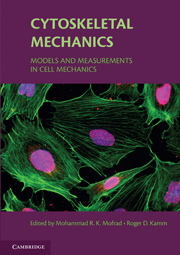Book contents
- Frontmatter
- Contents
- List of Contributors
- Preface
- 1 Introduction, with the biological basis for cell mechanics
- 2 Experimental measurements of intracellular mechanics
- 3 The cytoskeleton as a soft glassy material
- 4 Continuum elastic or viscoelastic models for the cell
- 5 Multiphasic models of cell mechanics
- 6 Models of cytoskeletal mechanics based on tensegrity
- 7 Cells, gels, and mechanics
- 8 Polymer-based models of cytoskeletal networks
- 9 Cell dynamics and the actin cytoskeleton
- 10 Active cellular protrusion: continuum theories and models
- 11 Summary
- Index
4 - Continuum elastic or viscoelastic models for the cell
Published online by Cambridge University Press: 10 November 2009
- Frontmatter
- Contents
- List of Contributors
- Preface
- 1 Introduction, with the biological basis for cell mechanics
- 2 Experimental measurements of intracellular mechanics
- 3 The cytoskeleton as a soft glassy material
- 4 Continuum elastic or viscoelastic models for the cell
- 5 Multiphasic models of cell mechanics
- 6 Models of cytoskeletal mechanics based on tensegrity
- 7 Cells, gels, and mechanics
- 8 Polymer-based models of cytoskeletal networks
- 9 Cell dynamics and the actin cytoskeleton
- 10 Active cellular protrusion: continuum theories and models
- 11 Summary
- Index
Summary
ABSTRACT: Cells can be modeled as continuum media if the smallest operative length scale of interest is much larger than the distance over which cellular structure or properties may vary. Continuum description uses a coarse-graining approach that replaces the contributions of the cytoskeleton's discrete stress fibers to the local microscopic stress-strain relationship with averaged constitutive laws that apply at macroscopic scale. This in turn leads to continuous stress-strain relationships and deformation descriptions that are applicable to the whole cell or cellular compartments. Depending on the dynamic time scale of interest, such continuum description can be elastic or viscoelastic with appropriate complexity. This chapter presents the elastic and viscoelastic continuum multicompartment descriptions of the cell and shows a successful representation of such an approach by implementing finite element-based two-and three-dimensional models of the cell comprising separate compartments for cellular membrane and actin cortex, cytoskeleton, and nucleus. To the extent that such continuum models can capture stress and strain patterns within the cell, it can help relate biological influences of various types of force application and dynamics under different geometrical configurations of the cell.
Introduction
Cells can be modeled as continuum media if the smallest length scale of interest is significantly larger than the dimensions of the microstructure. For example when whole-cell deformations are considered, the length scale of interest is at least one or two orders of magnitude larger than the distance between the cell's microstructural elements (namely, the cytoskeletal filaments), and as such a continuum description may be appropriate.
- Type
- Chapter
- Information
- Cytoskeletal MechanicsModels and Measurements in Cell Mechanics, pp. 71 - 83Publisher: Cambridge University PressPrint publication year: 2006
- 3
- Cited by

